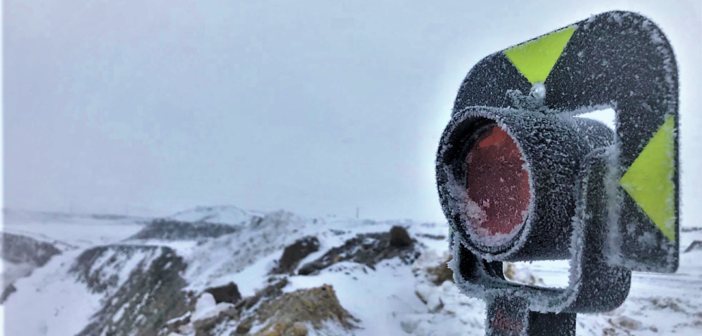You cannot make an accurate measurement without a good quality prism. While the prism has a relatively simple job in the process of electronic distance measurement – to reflect a signal – its ability to do this well depends on a number of factors. The quality of the materials used and the care taken in the production process have a huge impact on its accuracy and its ability to withstand harsh conditions on a job site. Here we look at the way reflectors in the Leica Geosystems Originals Accessories range are created to explain why choosing the right prism matters.
What makes a prism a good prism?
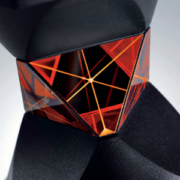 A good prism reflects back as much of the signal it receives as possible. To do this, it must be well-made, and well-protected so its accuracy isn’t affected by its environment. It should be able to cope with the distances that you need, for example, short or long distances require different coatings. And it needs to be so robust that it can drop from the height of a pole and still be as good as new. Leica Geosystems prisms are manufactured from glass of the highest quality, using sophisticated production techniques, strict assembly and quality control. Let’s look at the difference that makes to a prism’s accuracy and working life.
A good prism reflects back as much of the signal it receives as possible. To do this, it must be well-made, and well-protected so its accuracy isn’t affected by its environment. It should be able to cope with the distances that you need, for example, short or long distances require different coatings. And it needs to be so robust that it can drop from the height of a pole and still be as good as new. Leica Geosystems prisms are manufactured from glass of the highest quality, using sophisticated production techniques, strict assembly and quality control. Let’s look at the difference that makes to a prism’s accuracy and working life.
1. Prism alignment to prevent beam deviation
A prism is made from a glass block. The way that prism glass is manufactured plays a major role when reflecting signals. The accuracy of the cutting, grinding, polishing and mounting of the glass prisms directly influences how much EDM signal is returned from the reflector to the total station. The more accurate the corner angles and surfaces of the glass are ground, the better the signal will be returned in the same direction and the better its intensity. If the angle of the prism is only a few seconds out of specification, the returned signal will miss the instrument and the distance cannot be measured.

2. Special coatings to improve performance: copper and anti-reflex
How well a prism reflects the infrared EDM signal depends on the material it’s made of and its surface quality. Leica Geosystems’ reflectors are coated with copper because it offers the best reflectivity across the range of EDM wavelengths used by Leica Geosystems total stations (660nm – 850nm), it’s a robust material and it doesn’t corrode, thanks to an appropriate lacquer layer on top of the copper coating. We also use an anti-reflex coating to prevent measurement errors at close range. Prisms without anti-reflex coating often cause errors at short distances because the front of a prism always directly reflects a certain percentage of a signal and could create a false reading.
3. Centering Accuracy
Apart from the high-quality prism, an important factor when it comes to accurate surveying is what we call centering accuracy. Centering accuracy is the alignment and proper placement of the prism in the prism holder and the mounting stud. There is a high risk of measurement errors when original prism holders are not used, as these “Leica-like” holders are not configured according to Leica Geosystems standards.
4. Weather-proofing to avoid “reflector-blindness”
Unless a prism unit is properly sealed, its surrounding environment can enter and destroy its ability to reflect, making it blind. Often prisms are left out in the field for a long time, especially if they are being used for monitoring, so they need to withstand harsh conditions. For example, one of our total station customers reported that their reflectors, which were attached to a railway line, couldn’t be measured to. We investigated and found that the reflectors were poor copies of Leica Geosystems Originals Accessories prisms and didn’t have the protective layers we use. Weeds and vegetation are prevented from growing in the area of railway lines by frequently spraying along the line with powerful weed-killers. The weedkiller had eaten away at the prisms and killed their reflectivity.
A Leica Geosystems prism actually includes three layers of protection, in addition to its copper coating layer. An adhesive coating fixes the copper coating to the glass, a protective coating protects the copper layer, a lacquer seals all layers and finally, an antireflective layer in front adds an additional cover from environmental influences to the prism to ensure a long life.
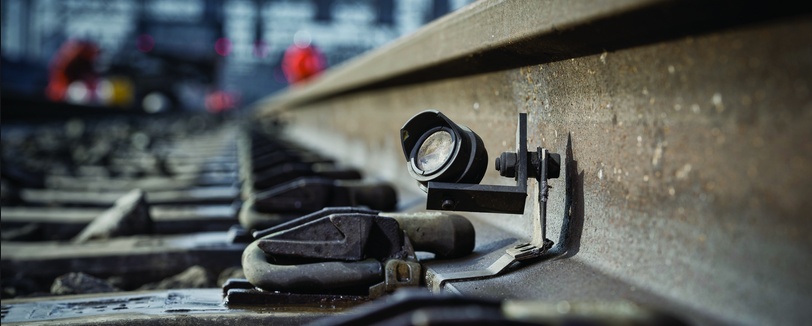
Non-Leica Geosystems reflector mounted on railway tracks that has lost reflectivity.
Manufacturing a Leica 360° reflector: 90 processes over six months
Believe it or not, it takes six months to manufacture a 360° reflector from a glass block, a journey that includes 90 individual processes. The 360° prisms are designed for use with state-of-the-art robotic total stations which have automated technology that locks on to a prism without the operator at the pole needing to re-align it. Omni-directional, they consist of six triple prism-glass bodies, tightly assembled in a patented process.
Why does it take so long? Firstly, glass pyramids are created from a glass cube by cutting and then grinding the six sides of the cube to an angular accuracy of less than eight seconds. They are then polished to achieve a surface that is flat to a 2-digit nanometre – that’s one billionth of a metre – by hand, using optical contact bonding. Triangular pyramids of the same size are then ground from the cube and are subject to the same polishing. Next, the glass pyramids have layers of coating applied in a “clean-room” in a vacuum, under specific climatic conditions. They are then glued together using a slow-drying adhesive. The entire assembly process takes two weeks, during which the hardening process takes the most time. Next, the glass is mounted into the rubber, enhanced with a carbon or metal rod, and then becomes fully recognisable. Before a production lot leaves us, a sample is subject to a series of strict quality tests – one of which is the pole drop test.
The 2m pole-drop prism test
It’s a fact of life that prisms will get dropped on the floor. Surveyors lean poles against walls, walk away and the pole falls over. It needs to survive intact and to make sure ours do, the 2m pole-drop test is one of the many quality tests at Leica Geosystems. The video below shows a drop test, which was conducted following our standard rules: the pole is 2m tall, it is allowed to fall from a vertical position and the fall is onto a hard wood surface placed on concrete. In the video three reflectors are tested: the Leica GRZ4 (360° reflector used for “normal” one-person survey work), the Leica GRZ122 (360° reflector strengthened for use as a SmartPole) and a copy of a Leica GRZ122. Watch the difference that Leica protection gives.
Risks of using a poor prism and how to spot a fake
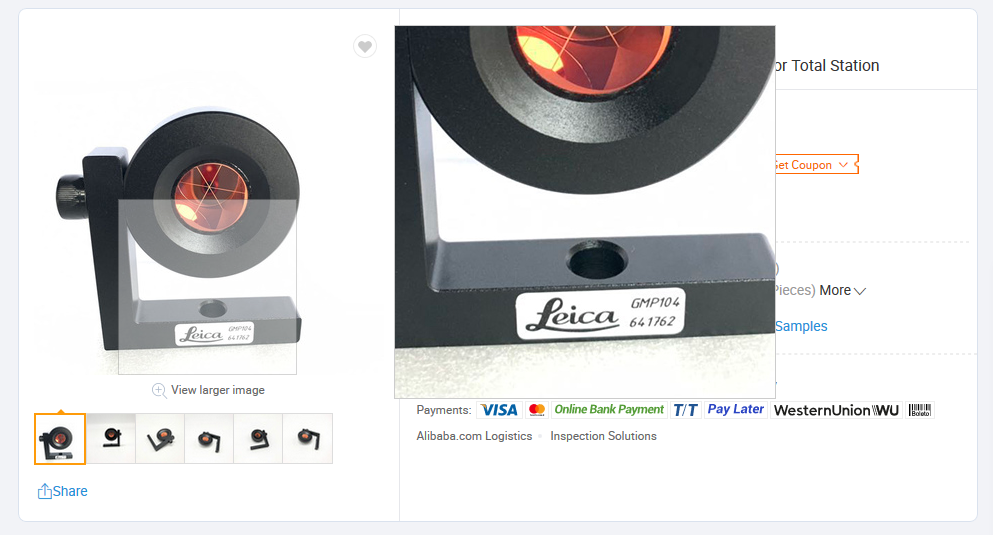
A “Leica-like” prism purchased online
Using poor quality accessories can affect your work. A badly constructed prism will prevent you from getting accurate measurements, regardless of the quality or the cost of your total station. Even for surveying tasks that can tolerate a broader range of accuracy, in centimetres rather than millimetres, poor quality prisms won’t be useful for long because of their fragility.
Leica Geosystems customer service teams investigate any reports from customers that a Leica survey solution is not giving accurate results. We often find that the problem is being caused by third party accessories, many claiming to be ‘Leica-like’. This was the case for one of our customers who reported the 360° reflector they were using was not of the quality they expected from a Leica Geosystems accessory.
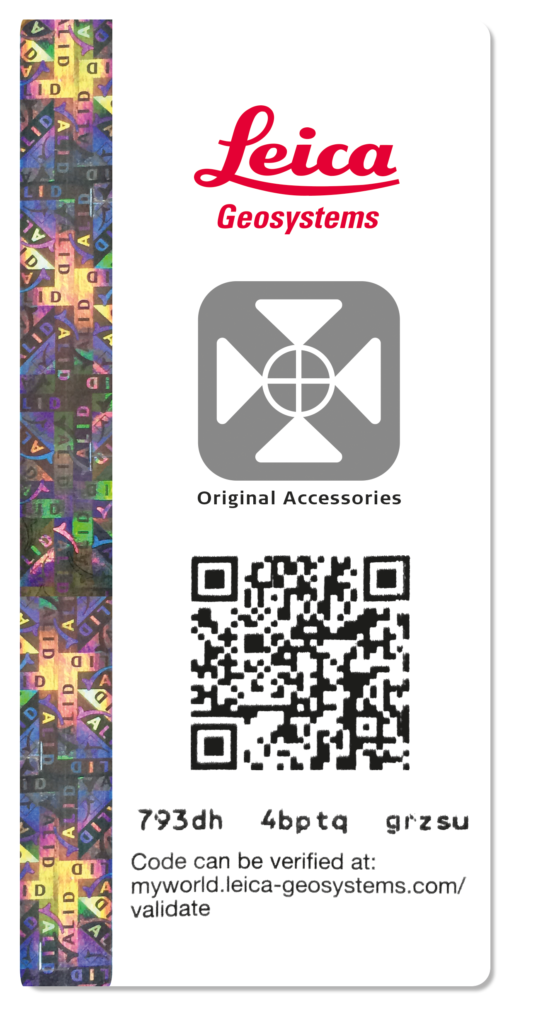
They said it was breaking apart when dropped from a height of only 1.3 metres. When we received the reflector for testing, we found it was a fake; the glass coatings were of poor quality and the glue was weak. Even the carbon rod that goes through the prism and is used for stabilisation was not built in, leading to this easy breaking. Unfortunately, the customer had bought from a seller on eBay and wasn’t able to get a refund. What seemed like a good deal was too good to be true – they lost money and valuable time on their project.
An original Leica Geosystems prism will always have a unique security code on the box that guarantees that what you’re buying is part of the Leica Geosystems complete solution. You can verify a product by entering its code online at the Leica Geosystems MyWorld portal or by scanning the QR code using any QR code reader. A genuine Leica Geosystems accessory comes with an exchange and replacement parts guarantee to give you peace of mind. For some products, we even guarantee to replace parts even if the product should be discontinued.
Find out here more information about Leica Geosystems prisms and reflectors.
All Leica Geosystems accessories follow high-quality manufacturing processes to ensure the best results in the field. Interested to know how the Leica Geosystems tripods are made and how they compare to non-original ones? Read here our blog about tripods and tribrachs!

Gerhard Soenser
Product Manager Accessories
Leica Geosystems AG














